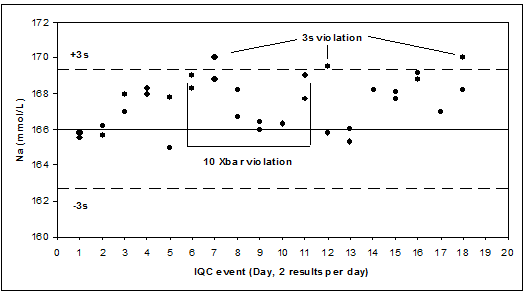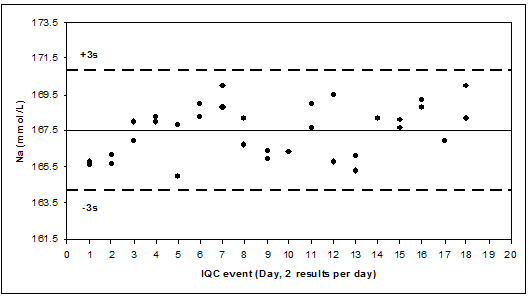Guest Essay
Dietmar Stockl, QC Reality Check, Part Three
Part three of an ongoing series on Internal Quality Control (IQC) by Dietmar Stockl. Dr. Stockl looks again at QC data examples from the real world of the laboratory.
Internal Quality Control - A Reality Check
- Part I: Setting the scene
- Part II: “Pearls on a rope”
- Part III: Purposely working with the “wrong target”
- Part IV: Purposely working with the “wrong standard deviation”
- Part V: How variable/stable do I want it?
- Part VI: How stable can I get it?
- Part VII: What’s going on? – 1
DIETMAR STOCKL, PHD
MARCH 2011
Part III: Purposely working with the “wrong target”
QC practice 1
We are an organization with several laboratories. We use the same assays (instruments, reagents and calibrator lots) and the same IQC materials. Therefore, we use the same target value for the IQC material.
QC practice 2
We have a high volume analyzer with 3 different modules (channels). We use the same IQC material for all modules and we apply the same target value.
Reasoning
Convenience, for both.
Problems in daily practice
Both expressed a “bad feeling” with that practice and encountered problems.
What are the challenges?
Experience learns that laboratories that use the same control, same calibrator lots and analyzers will NOT produce the same results. Even, within 1 laboratory, 3 different channels (or modules) on 1 instrument will NOT produce the same results. Moreover, every channel will show instabilities at different points in time. Consequently, if one uses the same target for all, compromises have to be made.
Example, QC Practice 1, Sodium (1 target, several laboratories)
Overall target: 166 mmol/L; CV = 0.7%; Lab average: 167.5 mmol/L
IQC violations: 3 times 3s (with 36 results; theory: 1 of 370 results); 10 Xbar.
Lab-specific target: 167.5 mmol/L; CV = 0.7%
No IQC violations
“Message”
-If one uses the same target for different laboratories (modules, channels) one has to expand the range if one does not want to increase the false positives. Also, one has to be careful with Xbar and moving average rules.
-Expansion of ranges (= changing the “stable SD”), however, should be very carefully thought about (see Part IV: Purposely working with the “wrong standard deviation”).
Conclusion
1 target for all: “it depends”
It depends on how much the laboratories/modules differ!
This leads us to Part V: How variable/stable do I want it?
One has to decide about the biases that can be tolerated from the medical point-of-view.
CAVE
Do not forget: what you see in your IQC, typically, is reflected in your patient data. If IQC differs, your patients differ!
Setting laboratory-specific targets will NOT help for patient data! However, laboratory-specific targets allow a better process control!
